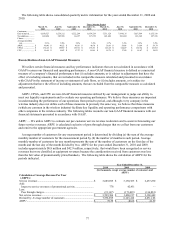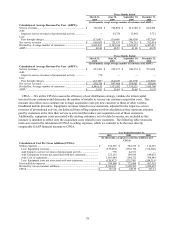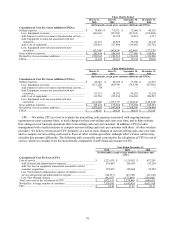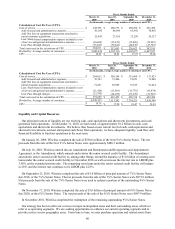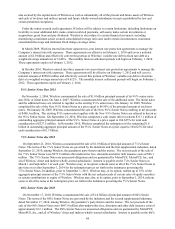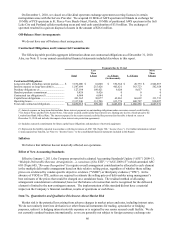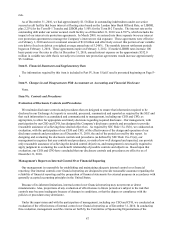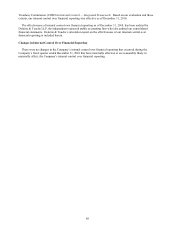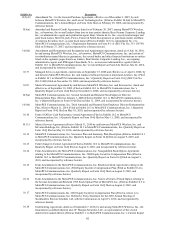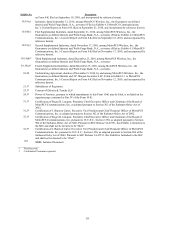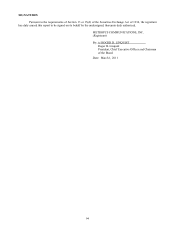Metro PCS 2010 Annual Report Download - page 97
Download and view the complete annual report
Please find page 97 of the 2010 Metro PCS annual report below. You can navigate through the pages in the report by either clicking on the pages listed below, or by using the keyword search tool below to find specific information within the annual report.
87
risk.
As of December 31, 2010, we had approximately $1.5 billion in outstanding indebtedness under our senior
secured credit facility that bears interest at floating rates based on the London Inter Bank Offered Rate, or LIBOR,
plus 2.25% for the Term B-1 Tranche and LIBOR plus 3.50% for the Term B-2 Tranche. The interest rate on the
outstanding debt under our senior secured credit facility as of December 31, 2010 was 4.597%, which includes the
impact of our interest rate protection agreements. In March 2009, we entered into three separate two-year interest
rate protection agreements to manage the Company’s interest rate risk exposure. These agreements were effective
on February 1, 2010 and cover a notional amount of $1.0 billion and effectively convert this portion of our variable
rate debt to fixed rate debt at a weighted average annual rate of 5.246%. The monthly interest settlement periods
began on February 1, 2010. These agreements expire on February 1, 2012. If market LIBOR rates increase 100
basis points over the rates in effect at December 31, 2010, annual interest expense on the approximate $532.0
million in variable rate debt that is not subject to interest rate protection agreements would increase approximately
$5.3 million.
Item 8. Financial Statements and Supplementary Data
The information required by this item is included in Part IV, Item 15(a)(1) and is presented beginning on Page F-
1.
Item 9. Changes in and Disagreements With Accountants on Accounting and Financial Disclosure
None.
Item 9A. Controls and Procedures
Evaluation of Disclosure Controls and Procedures
We maintain disclosure controls and procedures that are designed to ensure that information required to be
disclosed in our Exchange Act reports is recorded, processed, summarized and reported as required by the SEC and
that such information is accumulated and communicated to management, including our CEO and CFO, as
appropriate, to allow for appropriate and timely decisions regarding required disclosure. Our management, with
participation by our CEO and CFO, has designed the Company’s disclosure controls and procedures to provide
reasonable assurance of achieving these desired objectives. As required by SEC Rule 13a-15(b), we conducted an
evaluation, with the participation of our CEO and CFO, of the effectiveness of the design and operation of our
disclosure controls and procedures as of December 31, 2010, the end of the period covered by this report. In
designing and evaluating the disclosure controls and procedures (as defined by SEC Rule 13a-15(e)), our
management recognizes that any controls and procedures, no matter how well designed and operated, can provide
only reasonable assurance of achieving the desired control objectives, and management is necessarily required to
apply judgment in evaluating the cost-benefit relationship of possible controls and objectives. Based upon that
evaluation, our CEO and CFO have concluded that our disclosure controls and procedures are effective as of
December 31, 2010.
Management’s Report on Internal Control Over Financial Reporting
Our management is responsible for establishing and maintaining adequate internal control over financial
reporting. Our internal controls over financial reporting are designed to provide reasonable assurance regarding the
reliability of financial reporting and the preparation of financial statements for external purposes in accordance with
generally accepted accounting principles in the United States.
Because of its inherent limitations, internal control over financial reporting may not prevent or detect
misstatements. Also, projections of any evaluation of effectiveness to future periods are subject to the risk that
controls may become inadequate because of changes in conditions, or that the degree or compliance with the
policies or procedures may deteriorate.
Under the supervision and with the participation of management, including our CEO and CFO, we conducted an
evaluation of the effectiveness of internal control over financial reporting as of December 31, 2010. In conducting
this evaluation, management used the criteria set forth by the Committee of Sponsoring Organizations of the


